Actively Pursuing Passivhaus Enclosures
With high-performance curtain walls and windows, thermal bridge-free designs, and airtight building enclosures, more U.S. projects seek to achieve the rigorous European-based Passivhaus standard
![]() Continuing Education
Continuing Education
Use the following learning objectives to focus your study while reading this month’s Continuing Education article.
Learning Objectives - After reading this article, you will be able to:
- Describe how Passivhaus designs deliver superior energy efficiencies, better indoor air quality, outstanding acoustics, and enhanced occupant health and comfort.
- Explain how carefully designed and fabricated curtain wall systems within an airtight building envelope can help building teams achieve rigorous Passivhaus standards.
- Evaluate the performance benefits and superior thermal and visual comfort levels that Passivhaus-certified curtain wall systems and windows provide.
- Recognize the cultural, market, and building practice differences between the United States and Europe, and the challenges posed by local adoption of the European-based Passivhaus system.
As the pursuit of sustainable, energy-efficient buildings continues to intensify, a more rigorous building design certification is starting to gain traction here in North America.
Originally developed in Germany in 1990 and well-established in Europe, the Passivhaus standard produces extremely low-energy buildings with high-performance, airtight building enclosures.
“One of the most effective and proven tools we have to drive down carbon emissions and reach a post-carbon world is Passive House,” say Bronwyn Barry and Ken Levenson, co-presidents of the North American Passive House Network (NAPHN) in Passive House Accelerates, an in-depth review of the standard’s development for residential and commercial buildings—called Passive House in lieu of Passivhaus—in North America.

Image courtesy of FXFOWLE
Ultra energy-efficient, European-originated Passivhaus building designs are viable in North America, concludes FXFOWLE in a New York State Energy Research and Development Authority-sponsored study of a large, mixed-use New York City multifamily housing development with a curtain wall system. The base-case building used for the study is pursuing LEED Silver.
“A Passivhaus building meets the world’s most stringent operating energy-efficiency standard and generally will produce the least climate-changing emissions,” echoes Christina Snyder, Passive House Institute U.S.-accredited building certifier and principal of Equilibrium Energy Spaces, Manchester, Michigan.
Although the market conditions, climate, and culture are riper for Passivhaus buildings overseas, interest in the standard is growing as more North American Passivhaus projects are establishing the fact that the strict standards can be realized stateside.
In a new study sponsored by the New York State Energy Research and Development Authority (NYSERDA), FXFOWLE Architects Principal Ilana Judah, International Associate AIA, OAQ, LEED AP, CPHD, and Senior Associate Daniel Piselli, AIA, LEED AP, CPHD, analyzed a large, mixed-use New York City multifamily housing development currently under construction. The report concludes that high-rise residential buildings in New York can be designed to Passivhaus’ high levels of energy efficiency and resilience. Information taken from this report was current as of press time, but may be adjusted in future versions of the report.
The report, “Feasibility Study to Implement the Passivhaus Standard on Tall Residential Buildings,” also finds that Passivhaus can be achieved with limited aesthetic adjustments and reasonable glazing ratios in a financially viable manner.
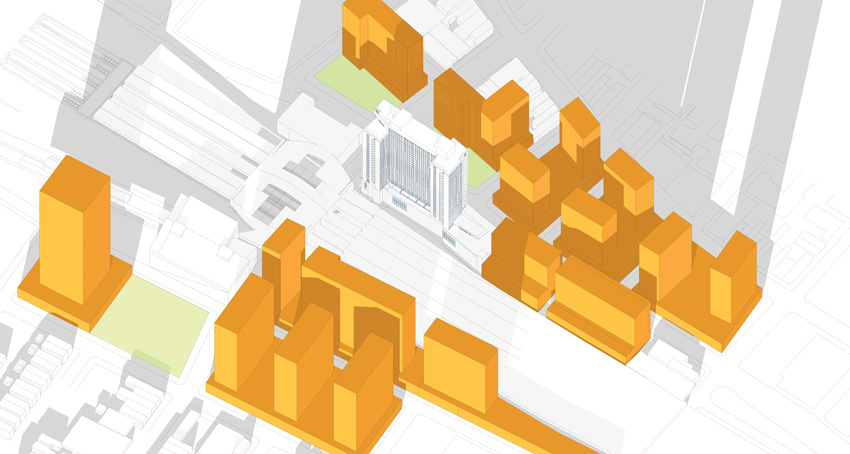
Image courtesy of FXFOWLE
Within the context of the densly packed New York City, FXLOWLE’s NYSERDA report suggests that aggressive, energy-efficent Passivhaus designs are feasible.
As noted by Judah and Piselli, the German term Passivhaus is often referred to in English as “Passive House.” This course, and the report, use the German term because the English word “house” can cause misperception that the standard is only for single-family houses. Passivhaus can be translated from German to a more applicable English phrase “passive building.”
The Passivhaus Blueprint
To meet the Passivhaus standard, building designs must achieve high performance in the following areas: thermal insulation, thermal bridge-free design, airtightness, and windows and mechanical ventilation with heat recovery.
Ultra-low energy consumption requirements include 4.75 kBtu/{ft2yr} in heating demand, 5.39 kBtu/{ft2yr} for cooling demand, and a total building primary energy demand of 38.0 kBtu/{ft2yr}. For airtightness blower testing must produce 0.6 ACH@50Pa.
Granted, achieving these rigorous performance levels is requiring greater effort from architects, engineers, and contractors, but the benefits are worthwhile.
As laid out by Deborah Moelis, AIA, senior associate for Handel Architects, Passivhaus buildings yield building energy savings of 60 to 70 percent in heating and cooling, produce an acoustically superior, comfortable indoor environment, and deliver better indoor air quality free of condensation and mold.
“Passivhaus is a whole systems-integrated approach to designing the best, most efficient building envelopes possible,” Snyder says.
Beyond good design, Passivhaus advocates assert that the system delivers the triple bottom line benefits of lower operating costs, a more durable building, and enhanced occupant health, comfort, and performance.
In fact, the Geneva-based Intergovernmental Panel on Climate Change identified Passivhaus as one of the only whole-building strategies capable of reducing building energy use enough to achieve greenhouse gas mitigation targets for the building sector.
Buildings pursuing Passivhaus will have an easy time meeting the less-stringent energy-code requirements currently in place. Very similar to Passivhaus, the 2012 International Energy Conservation Code now requires air duct tightness, mandatory blower testing, additional wall insulation, increased fenestration U-factor thermal performance and decreased heat gain, and energy-efficient lighting and equipment.
“It is as if the building industry that has long focused on improving energy efficiency in buildings by upgrading the efficiency of the mechanical equipment has had a collective awakening. It’s the envelope!” writes architect Laura Nettleton, founder of Pittsburgh-based Thoughtful Balance Architecture, in her blog “Passive House Is Coming—Ready or Not.”
Starting to jump on board, close to a dozen states—including Pennsylvania, New York, Rhode Island, Massachusetts, Connecticut, New Jersey, New Hampshire, Idaho, Ohio, Illinois, and South Dakota—are now including Passive House certification as earning potential points in their state’s Low Income Housing Tax Credit and qualifying for 9 percent in tax credits.
“A building meeting the Passive House Standard aligns well with the Architecture 2030 goals, California’s impending net-zero energy requirements, New York City’s building operating energy goals, and Vancouver, British Columbia’s incentives,” Snyder adds.
New York City, in its Local law 31, is targeting City buildings to achieve a 50 percent reduction in energy use intensity or meet Passivhaus energy use intensity targets. “This is a very ambitious target,” reports Judah of FXFOWLE. “City agencies have also been championing Passivhaus with City-funded Requests for Proposals and the New York City Housing Authority including Passivhaus language in recent RFPs. The City also has an overall goal of meeting an 80 percent reduction in greenhouse gas emissions by 2050.”
Along these lines, New York City’s Zone Green zoning incentive directs that a portion of a building’s exterior wall—up to 8 inches—can be excluded from floor area calculations if the wall’s thermal performance exceeds code requirements. The goal is achieving high-performance enclosures and energy efficiency by encouraging developers to provide more highly insulated exterior walls.
In addition, New York City is now mandating blower door tests in buildings between 25,000 and 50,000 square feet, and the option of a blower door test or providing an air leakage plan for buildings larger than 50,000 square feet.
Passivhaus and Curtain Wall
Debunking the misperception that Passivhaus buildings are dark spaces with little glass, architects aren’t hesitating to include curtain wall systems in these projects.
Unlike small glazing panels, the larger panels that are incorporated into curtain wall systems lose less heat at the frames and edges. Compared to window walls, curtain walls deliver better airtightness, less thermal bridging, reduced framing systems, and increased sight lines. “If the curtain wall is prefabricated off-site, a portion of the insulation and air-sealing aspects of the Passivhaus envelope can be completed in very controlled conditions, in a factory setting away from cold or wet conditions,” says Stas Zakrzewski, AIA, LEED AP, a Certified Passive House Consultant and principal of ZH Architects.
For the Passivhaus-certified, 18,000-square-foot Kiln Apartments project in Portland, Oregon, GBD Architects specified wood stud framing with a liquid-applied membrane, exterior insulation, and very high-performing windows. However, constructing the building was very challenging, reports Agustin Enriquez V, a principal of GBD. In retrospect, “a curtain wall facade system would have sped up construction dramatically, and in our experience with high-rise buildings, the quality control would have been much higher,” he explains.
With unitized curtain walls, Enriquez points out that the joints are very consistent between units. “Solving the jamb, head, and sill at one time, with factory quality control, installation is much easier and can eliminate a lot of the installation challenges we have experienced,” he says.
Curtain walls also integrate well with double-skin facades. With an exterior glazed appearance and inner wall, requiring less glass, these double-wall systems—popular in Europe—offer glass facade aesthetics with better energy performance. While U.S. designers have experimented with double-skin designs, the technology has yet to catch on widely here. But with more domestic research and development, designers anticipate this will start to change.
In any case, a curtain wall’s modern appearance and expansive glass aesthetics make it an appealing choice for commercial facilities. That said, building orientation and wall-to-window ratio must be carefully calculated to maximize its efficiency.
“If one entirely clads a building with a uniform curtain wall glazing system or doesn’t think about the orientation of the glazing with regard to the winter and summer sun paths, one can end up putting transparent glazing where it will work against the building in space conditioning the envelope, rather than working for the building, and this could make it very difficult to meet the Passivhaus standard,” Snyder says.
Designers must also consider internal heat gain, the potential need for shading devices, and thermal loss from the curtain wall frames.
Regarding the latter, Judah sees research and development opportunities for curtain wall manufacturers to design higher-performing, thermally broken frames, spandrels, and other components.
One way that Handel Architects addressed this issue for the design of a 26-story academic residence tower for Cornell Tech’s new Roosevelt Island campus in Manhattan was the specification of a mega panel. As opposed to a curtain wall, the panel-to-panel joints—which are the weakest thermal part of a building’s facade—are minimized, Moelis says. Whereas a typical curtain wall utilizes 4-foot-wide panels, the mega-panel system at Cornell Tech is approximately 36 feet wide.

Image courtesy of Handel Architects
When completed, this 26-story academic residence tower for Cornell Tech’s new Roosevelt Island campus is anticipated to be the largest Passivhaus residential building in the world.
Furthermore, the introduction of thermal breaks in panel structure and exterior finish support clips supports increased R-values. In fact, the thermally broken windows deliver an excellent U-value of 0.17, which is drastically lower than the 0.44 to 0.46 R-value range for typical windows. This hybrid mega-panel technology also combines the features of a wall and a window where individual panels are not structurally dependent on the adjacent panels.
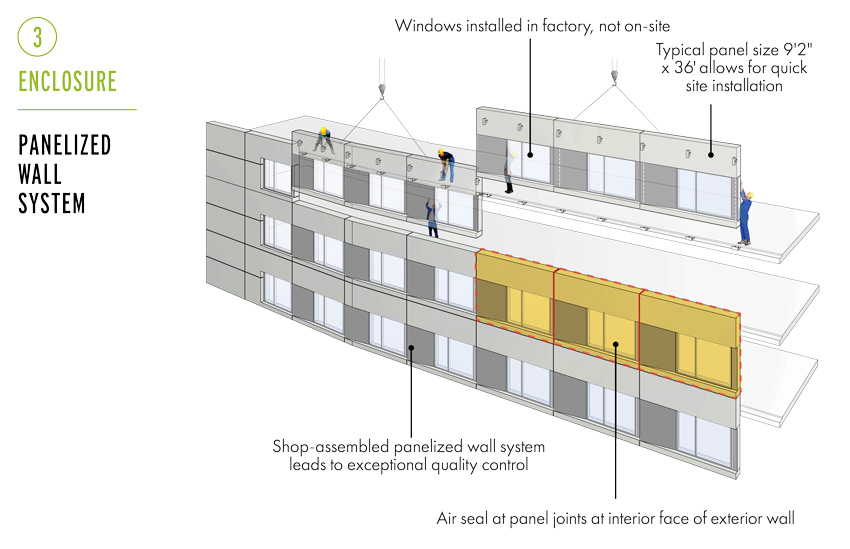
Image courtesy of Handel Architects
Specifying a mega-panel system in leui of a curtain wall, larger panel sizes and fewer joints deliver better thermal insulation for the Cornell Tech residence tower.
While continuous insulation (ci) has been a bonus, not to mention the fact that the ci completely passes by slab edges because the panel is hung off of the building, at the same time, the project’s Passive House consultant Lois Arena, PE, CPHD, senior mechanical engineer for Steven Winter Associates, admits that attaching the mega panels to the frame has created challenging thermal bridging issues. As she explains in NAPHN’s Passive House Accelerates, “to keep those panels securely attached to the frame, there are 123 anchors on each floor, and each one of those anchors has to be insulated and air sealed.”

Image courtesy of Handel Architects
Carefully detailed air sealing will help Cornell Tech achieve a rigorous Passivhaus airtight envelope standard of 0.6ACH@50pa.
Of course, curtain walls’ large expanses of glass enable larger solar heat gains than smaller punched windows. Carefully integrated solar shading can help address this issue, while simultaneously serving as a design feature. However, in order to attach the shading device directly to the curtain wall, Piselli explains that a structural connection has to be made, thereby creating a technical challenge to maintaining the thermally broken frame.
“The most challenging aspect at the moment is limited ‘off-the-shelf’ thermally broken Passive House-level curtain wall systems that are tested to U.S. standards,” Zakrzewski says.
While the technology is available in Europe, there’s the chicken-and-egg issue of market demand. “With the assorted certifications and costs, there is not yet much incentive to bring these products to the United States,” Judah explains.
“There have to be ways for United States companies to partner with European manufacturers to help bring these products to the market here,” she continues. “The technology is out there; it’s just a question of access and competitive pricing.”Another challenge, says Enriquez, is the transition between the curtain wall units and roof or soffit. While difficult on any project, the issue of figuring out how to best seal and thermally isolate those joints is even more critical when attempting to meet Passivhaus standards.
Curtain Wall and Best Practices
Sharing some valuable tips for achieving Passivhaus requirements with curtain wall systems, Enriquez recommends keeping the architectural form simple (e.g., minimizing changes in planes). “This is not what architects like to hear necessarily, but the more ins and outs, and the more unique conditions, the more projects will be challenged to meet a very high level of performance criteria,” he says.
On a more detailed level, Enriquez encourages designers to anchor the curtain wall system at the slab edge. From a performance standpoint, face-of-slab attachment is preferable to a top-of-slab or below-slab attachment.
“We have done unitized curtain walls both ways, and from a design perspective, face of slab offers a lot of benefits during design,” he explains. “It can be a bit more challenging to install, but the performance benefits should make it a more attractive approach.”
Offering a number of best practices, Moelis advises:
- ensuring that some significant portion of the insulation passes by the edge of slab;
- making sure that all lintels, ties, and facade-support clips are thermally broken;
- documenting, detailing, and correctly building all penetrations through the facade in the field;
- ensuring extensive quality control during fabrication and construction; and
- clearly calling out all details and carefully coordinating unique products and specifications.
Meanwhile, Judah says that mockups are critical, especially with regard to ensuring that the curtain wall is being fabricated and constructed to pass airtightness testing.
“If a curtain wall system has not been designed to meet the Passivhaus airtightness standard of 0.6 air changes per hour at 50 pascals pressure differential, its air leakage will likely exceed that limit,” Snyder says.
Similarly, if the curtain wall system hasn’t been designed to thermally isolate the exterior of the framing system from the interior, there’s a good chance that thermal bridging will jeopardize the building’s energy, condensation, and comfort risk limit requirements.
To help mitigate all these issues, Snyder highly recommends choosing Passivhaus-certified curtain wall and glazing systems.“Manufacturers of Passivhaus Institute-certified curtain wall systems are aware of the need for a continuous air barrier and will have designed their components to be ultra airtight when installed correctly,” Snyder says. “They will also provide suggestions for how their systems should interface with other building components to achieve thermal-bridge free and airtight construction.”
Leveraging the PHPP Software Tool
Another advantage of specifying Passivhaus-certified curtain wall systems is their compatibility with the Passive House Planning Package (PHPP) software, which is required by all projects pursuing certification.
With all Passivhaus-certified product data preloaded into the software, building teams can avoid the additional effort and costs associated with digging up curtain wall performance data to input into the PHPP. Furthermore, they can avoid any deductions required by some uncertified products.
The tool is considered the most well researched and designed energy modeling software on the market when it comes to ultra high-performance buildings, according to Dylan Lamar, CPHC, an architect with Portland-based Green Hammer. He says PHPP outputs annual heating demand, maximum heating load, summer thermal comfort with active cooling, annual cooling demand, maximum cooling load, summer thermal comfort with passive cooling, frequency of overheating events, and annual primary energy demand for the whole building. “I feel the PHPP v9 is the best modeling software currently on the market,” he says.
“As an energy modeling software program, PHPP allows the user to accurately account for certain types of common thermal bridging using therm and associated calculations,” Zakrzewski explains. “We have found that there can be up to 30 percent loss in insulation efficiency when these losses are not accounted for so PHPP software very accurately represents the designs that are created,” he explains.
Similarly, Everhart describes PHPP as essential for modeling low-energy buildings, particularly as the design relates to the shading context of the surrounding neighborhood/landscape. The software enables the building team to “see the impact on the whole building energy performance of specific glazing decisions like locations and orientation of glazed building elements, size, operability, choice of glazing and frame types, use and extent of shading devices, as well as being able to see the impact of glazing choices on occupant comfort levels.”
With the help of the PHPP tool, designers can best size and locate glazing, and perform parametric studies of the differences in whole building performance given a set of glazing design decisions, including comparing the performance of a given manufacturer’s glazing products.
Included in PHPPs latest version 9 is a “traffic light” system that indicates whenever glazing units are losing so much heat that their interior surfaces do not meet Passivhaus criteria, thereby requiring supplemental heat to be supplied along the glazed perimeter for occupant comfort, according to Everhart.
If building teams opt for nonstandard curtain wall installation—for example, attaching to different building assemblies than shown in a manufacturer’s standard details—this needs to be calculated for use in PHPP as well.
“Manufacturers can typically recommend the person who did their typical detail calculations to assist the design team with per square inch (PSI) value calculations,” Everhart says.
With specific curtain wall systems built into the Components tab in PHPP’s latest version, this accounts for heat losses due to bolts and glass carriers, as well as the geometry of the installation. As an excellent tool for calculating thermal bridging energy loss, Zakrzewski will then leverage this valuable information to tweak his designs in order to drive the thermal loss down as much as possible.
To assist building teams with the PHPP software and other energy modeling, a list of Passivhaus-trained consultants and designers can be found at www.passivhausplaner.eu/index.php?lang=en-GB.
Passivhaus for New York High Rises
While the center of Passivhaus activity remains in Europe, momentum is slowly but surely ramping up here in the United States. Case in point, FXFOWLE makes a strong case for Passivhaus in New York City in the firm’s new “Feasibility Study to Implement the Passivhaus Standard on Tall Residential Buildings” report.
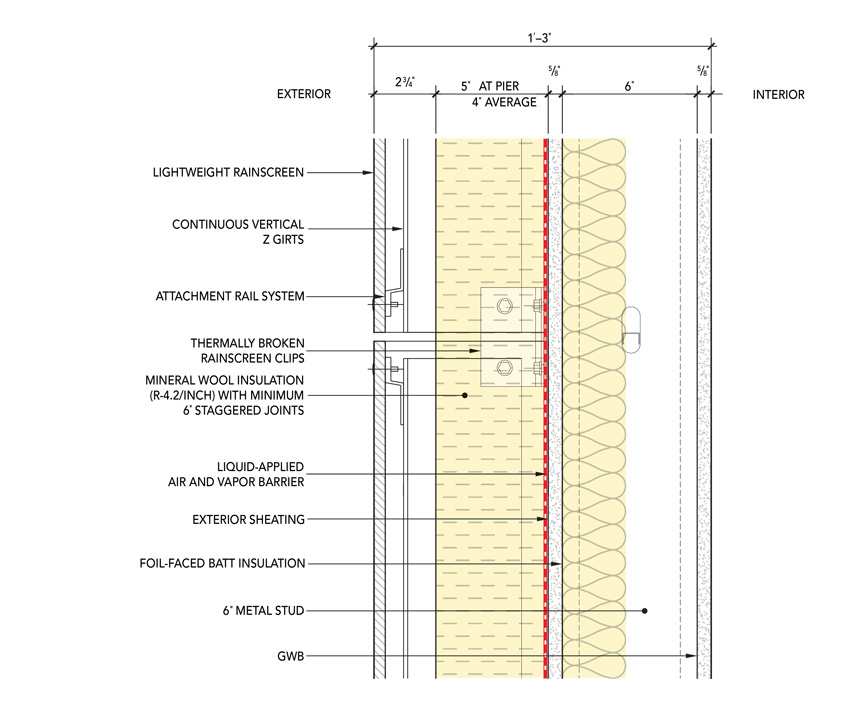
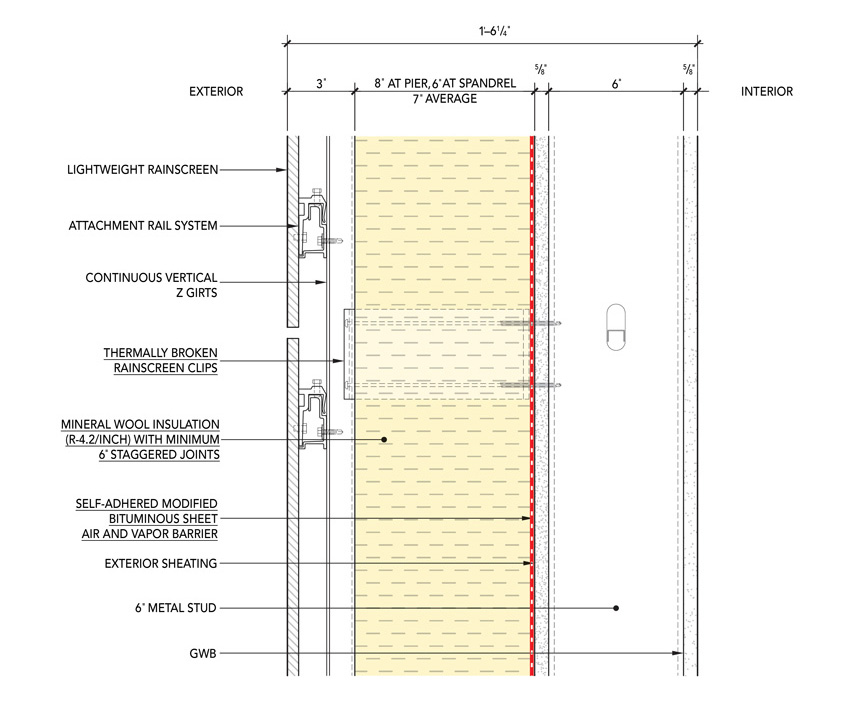
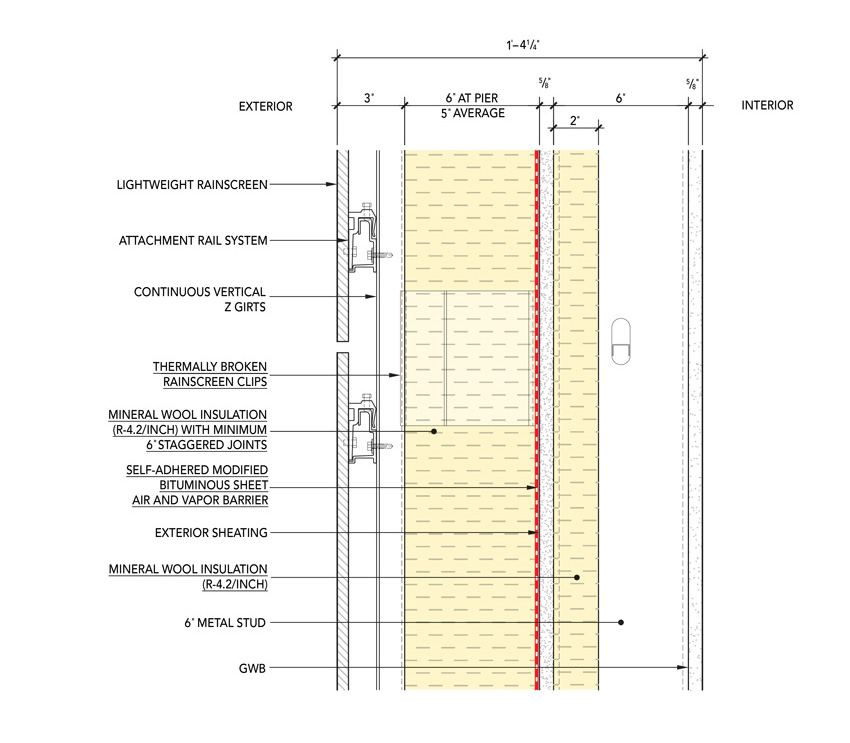
Images courtesy of FXFOWLE
A Passivhaus version of the base-case assembly uses thermally improved fiberglass attachment clips and uninterrupted, continuous insulation. From left: base case: lightweight rain screen steel stud backup (R-17.65); Passivhaus proposal: lightweight rainscreen with steel stud and exterior insulation (R-26); and Passivhaus alternate: lightweight rainscreen steel stud backup and interior & exterior insulation (R-26).
With a goal of investigating cutting-edge energy efficiency practices, influencing New York’s housing policy toward more ambitious energy and greenhouse gas reduction targets and encouraging local Passivhaus adoption, results from the firm’s analysis of a 593,000-square-foot, 26-story multifamily mixed-use building in Jamaica, Queens, strongly suggest that Passivhaus is applicable to tall buildings in New York City.
“Since New York has a challenging climate with cold winters and hot, humid summers, these results also suggest that Passivhaus is broadly applicable to cities in many climates,” state Judah and Piselli in the report. “Achieving the standard appears financially viable, and will become increasingly more cost effective as the design and construction industry becomes more experienced and familiar with Passivhaus.”
As the City’s overall aggregate energy use is so high, with heating accounting for the largest piece of the pie in terms of energy use and carbon footprint, Judah sees Passivhaus’ extremely aggressive approach to reducing heating loads as a huge opportunity.
Furthermore, the highly dense space and lack of roof area for solar energy makes net-zero designs difficult to achieve in the city, whereas Passivhaus provides a viable model for very low-energy buildings.
For the high-rise case study, the Passivhaus design—achieved via additional insulation, reduced thermal bridging, simplified air-barrier installation strategies, and triple-glazed insulated windows—is projected to save 47 percent in overall primary energy use. “These changes allow mechanical systems to be substantially reduced or eliminated, thereby reducing first costs, operations and maintenance costs, and replacement costs,” write Judah and Piselli.
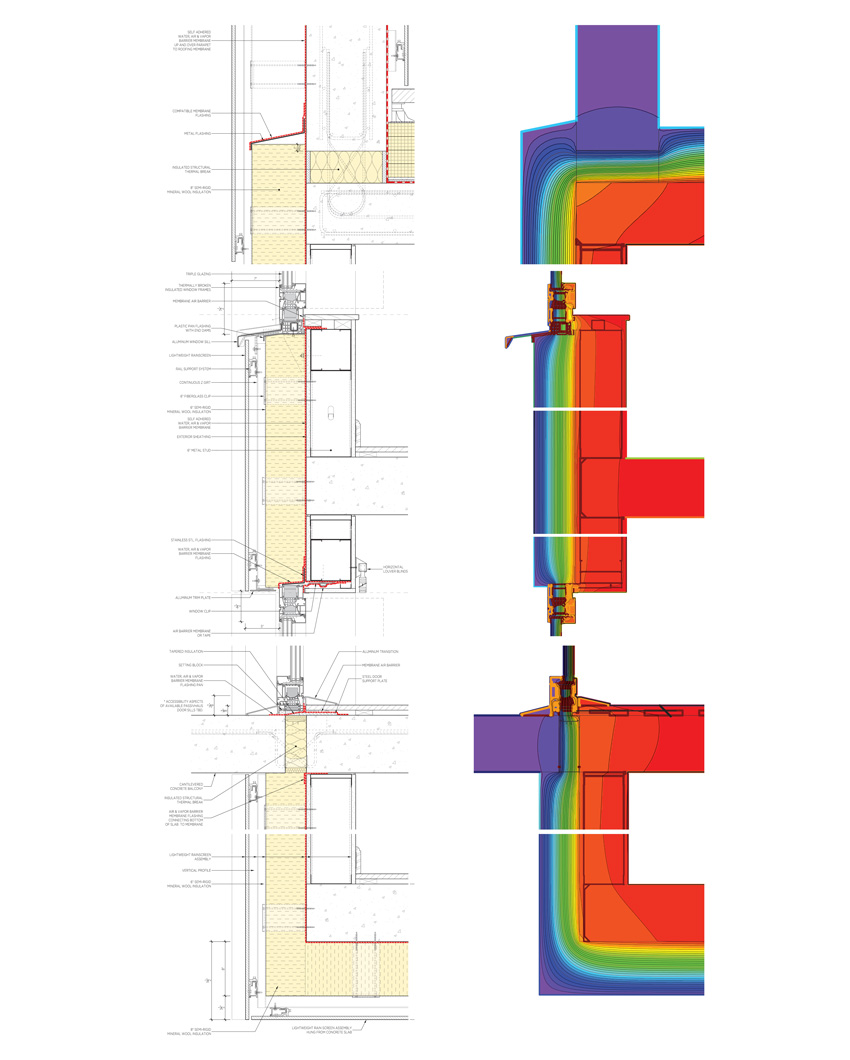
Image courtesy of FXFOWLE
Shown are assembled details of a lightweight rainscreen steel stud backup (left) and corresponding thermal bridge analyses of various junctions (right).
Describing the insulation and airtightness as the keys to achieving Passivhaus standards, the FXFOWLE architects recommend following the Air Barrier Association of America’s quality assurance protocol.
For this project, “we built in extra time and money for the quality assurance of the envelope construction,” Judah says. “We hope that eventually this would become standard practice and there would be no additional costs, but I think this level of due diligence is pretty critical.”
Additional best practices involve furnishing detailed 3-D drawings of key junctions for the contractor/subcontractors, bringing in Passivhaus-certified designers and installers, and recruiting a construction manager/general contractor who is highly committed to the Passivhaus goal.
Adopting European Passivhaus in the United States
While projects investigating Passivhaus, such as FXFOWLE’s study that uses a mixed-use high-rise pursuing LEED Silver as the base case, are making inroads, domestically, a number of factors are making the process somewhat challenging.
For starters, Piselli observes that European customs seem to accept spending money on the design and construction of high-quality buildings, whereas in the United States, there is a predisposition to cut costs at the expense of quality.
Furthermore, there are more aggressive political mandates and legislation governing energy-use reduction, in addition to the fact that northern and central Europe experience more temperate climates.
On the contrary, the United States has nine different climate zones, electrical plug loads are higher, and Americans prefer more artificial lighting, according to Nettleton.
“Culturally, people in Europe are more willing to accept a greater bandwidth of temperature swings,” Judah adds. In fact, “in Austria, some of the hospitals don’t even have air-conditioning.”
Another difference is that United States building owners, designers, and contractors aren’t used to the rigorous demands of the European Passivhaus system. “A degree of precision is demanded, which the United States building industry is not accustomed to accommodating,” Lamar explains. “However, it is clear than many teams are meeting this challenge and delivering excellent certified projects.”
That said, Europe also benefits from 20 years of experience designing and constructing Passivhaus buildings, whereas the knowledge base here in the United States is relatively small.
Yet another issue is the fact that the Passivhaus Institute bases its testing protocols on European standards. Here, the focus is making accurate predictions of the component’s performance in the context of its installation into a typical Passivhaus building so that the certification modeling results are accurate for use in PHPP building energy modeling, explains Snyder.
Some testing protocols in North America are focused on providing end users a single performance value for comparisons across product lines under a single set of test conditions that are not necessarily reflective of conditions in high-performance building envelopes like Passivhaus, Snyder says. Consequently, these test results cannot be used for accurate calculations of building components in Passivhaus buildings.
On the contrary, the PHPP software requires third-party test performance values for both the glazing units and frame components to accurately model the energy performance of windows of any size. However, in order to gather this information, manufacturers must be willing to undergo this testing, which is ultimately justified by a market for certified products.
“Unfortunately, the Passivhaus market has a harder time growing without the availability of precise performance values and certified products so it is a chicken-and-egg problem,” laments Snyder.
The metric versus imperial difference is a further complication when it comes to applying European Passivhaus standards to the United States.
“We are continuously needing to prod manufacturers for data that is in the European format,” Moelis says. “It’s encouraging that over the past few years, we’ve seen companies become more fluid, but it is difficult, for sure, as Americans are resistant to adopt European nomenclature.”
“Conversion is particularly burdensome during the submittal/shop drawing phase and leads to considerable challenges due to tight time constraints,” she adds.
Fortunately, PHPP software is available in both metric and inch-pound versions, helping alleviate the difficulty of converting units of measure.
Comparing Passivhaus to Other Rating Systems
While building teams have a number of sustainable building certifications to target when designing their latest high-performance facilities, Passivhaus is uniquely poised to deliver the very best in energy efficiency.
“The other systems cast a wider net and focus on a wider variety of environmental issues,” Nettleton says. “Each standard has its value, but there is really no comparison with these other systems when it comes to energy savings.”
“Passivhaus’ focus on energy efficiency, as opposed to a more holistic standard that tries to take everything on, means you get a superior building shell that is ‘future proofed’ for decades to come,” Hammer adds. “The efficiency performance is not watered down as it can be with other standards. It also facilitates actual deliver of energy performance much more effectively as verified by measured data.”
While some criticize Passivhaus as not fully focusing on operating energy and failing to set standards for other sustainability goals, Snyder points out that meeting the Passivhaus standard actually requires designers to address what she describes as other categories of green building goals.
“For instance, it isn’t possible to conserve enough energy to meet the Passivhaus standard if the designs doesn’t also practice extreme water conservation,” she explains. “And in an ultra airtight building like a Passivhaus, the impetus for eliminating VOC-emitting building materials becomes greater than ever, and the required ventilation mitigates remaining indoor pollutants.”
Furthermore, a Passivhaus envelope is foundational to achieving standards such as the Living Building Challenge and net-zero energy.
That said, LEED is practically considered standard practice, particularly in New York City, and some building owners would like to differentiate themselves. Highly proven in Europe, Judah anticipates that Passivhaus might be the next big thing here in the United States.
Bringing up another point, Nettleton notes that unlike some other rating systems, Passivhaus is not prescriptive and doesn’t dictate how to achieve the rating but only that the design hits the metrics. “This fact allows for creativity on the part of each team,” she says.
Handler agrees, explaining Passivhaus as a full-building design approach that gives the architect and engineer the freedom to meet certification requirements in a creative, independent manner.
“Passivhaus also allows the additional money spent to go into the quality of the building rather than third-party verification,” Nettleton adds.
Obstacles and Challenges
In terms of general impediments to a more widespread Passivhaus adoption in North America, Judah points out that there are a number of misperceptions that still need to be demystified—for example, that Passivhaus buildings don’t incorporate enough glass or operable windows, and that the tight building enclosure creates air-quality issues.
Furthermore, there is a common misperception that Passivhaus buildings are unattractive. “Ultimately, Passivhaus buildings in Europe look great, and we need a few good-looking projects to be built here,” Piselli explains. “It feels a lot like the early days of LEED where people were initially skeptical, but it didn’t take long to catch on.”
Judah also sees a need for more competitive building products, more training on the construction side, and better legislation favoring Passivhaus.
As things stand, the U.S. government provides generous subsidies for fossil fuels, while energy efficiency and renewable energy have not benefited from a level playing field, according to Everhart.
Furthermore, Passivhaus designs can’t offer the same curb appeal as wind or photovoltaic systems. “Movement attracts attention, but insulation doesn’t move,” Everhart explains. “Perhaps it is human to be more interested in producing energy than saving it, but Passivhaus is measured in ‘negawatts’—the energy you don’t use. It is not glamorous but reliable, and we believe it has the lowest environmental life-cycle cost.”
“Until the playing field is level, Passivhaus may largely appeal to people with particular environmental, social, and/or philosophical values, in addition to economic return,” he adds.
What's In Store
Judging from the code’s orientation toward stricter energy requirements, as time goes on, Passivhaus is well poised to help building teams navigate toward this direction.

Image courtesy of Handel Architects
Although Passivhaus advocates would like to see more Passivhaus-certified products and more favorable legislation in North America, they anticipate that these highly energy efficient, resiliant designs—like Cornell Tech’s new residence tower—will continue to gain traction.
“There has been a slow adoption of this standard in the United States, but there is evidence in the latest version of the IBC that all construction is headed toward additional insulation and minimizing air-infiltration,” says Nettleton. “I think most buildings will be built this way in the near future.”
While project teams have access to various sustainable design programs and certifications, Zakrzewski sums it up by saying, “Passivhaus buildings are on another level.”

|
The Ornamental Metal Institute of New York is a not-for-profit association created to advance the interests of the architectural, ornamental, and miscellaneous metal industries by helping architects, engineers, developers, and construction managers transform designs into reality. www.ominy.org |

